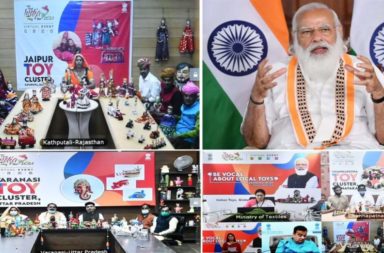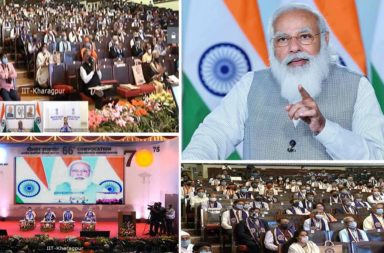The centuries old tradition of the humble chulha, a U-shaped clay or mud stove is most commonly used for cooking in many areas of rural India. Cooking is normally done in earthen pots by burning of solid fuels such as wood, animal dung, crop/agricultural residues, charcoal (biomass) fueled by kerosene or coal. This slow cooking over smoky flames enhances the flavor of the dish and retains the moisture and aroma of the food. Further, smoke from chulhas in open courtyards also keep homes free of mosquitoes and insects.
Although biomass is a renewable energy source, the incomplete combustion of fuel produces high levels of household air pollution (HAP) which poses a major global environmental health threat. Indoor air pollution can be up to 10 times worse than outdoor air pollution and it is one of the largest killers with close to half a million deaths in India each year. The emission includes a range of air pollutants and particulates and the use of kerosene to ignite a fire increases the concentration of pollutants such as black carbon (soot) in homes.
WHO estimates that around 3 billion people worldwide cook on open fires and simple stoves fuelled by kerosene, biomass and coal and each year close to 4 million people worldwide die prematurely from illnesses caused by this exposure. The pollution levels exceed the WHO guidelines and the health effect is determined not just by the pollution level but also the exposure level; the time spent breathing the polluted air.
One of the indicators under the UN 2030 Sustainable Development Goals (SDGs) Target 7 – “access to affordable, reliable, sustainable and modern energy for all” is also to “ensure clean cooking fuels and technologies”. The Sustainable Development Goals is a 15-year plan and a universal call for action by the 193 UN Member States to achieving a better and more sustainable future for all.
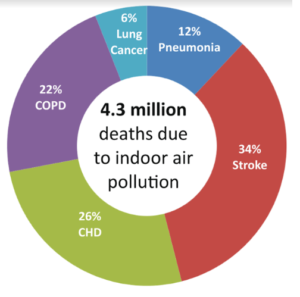
HEALTH IMPACT
While the focus has been more on air pollution impacting climate and the environment there has been a major shift to addressing the growing concerns of HAP and its adverse impact on health. Astounding data gathered from the Comparative Risk Assessment (CRA) exercise conducted by WHO including other exhaustive research, studies involving focus groups and published literature in India and globally show consistent and mounting evidence linking HAP to acute lower respiratory infections, ischemic heart disease, stroke, chronic obstructive pulmonary disease and lung cancer.
Women and children are particularly vulnerable to exposure of HAP and is responsible for a large percentage of all pneumonia related deaths in children less than 5 years old and acute lower respiratory infections and chronic obstructive pulmonary disease (COPD) in adults. The daily exposure to HAP also contributes to deaths due to stroke, ischemic heart disease and lung cancer. There is also evidence of links between HAP and low birth weight, tuberculosis, cataract, nasopharyngeal and laryngeal cancers and impairing of immune response.
INTERVENTIONS
India is making great strides in ensuring access and encouraging clean cooking with Liquefied Petroleum Gas (LPG), promoting biogas, smokeless improved cook stoves (ICS), electricity grid expansion, including a shift towards solar with charging batteries and piped natural gas (PNG) through its various targeted social welfare schemes.
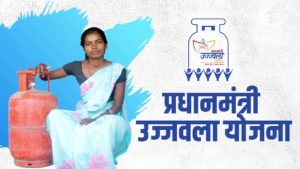
Since the 1970s, LPG has been the fuel of choice for the Government and over the years has implemented direct transfers and subsidy schemes to ensure it reaches the targeted population. The most prominent effort was the Pradhan Mantri Ujjwala Yojana (PMUY) launched in 2016 to provide 80 million connections to rural women of below the poverty line (BPL) households. This target was achieved 7 months before the deadline of 31 March 2020. In the earlier “Give It Up” campaign launched in 2015, over a million people also voluntarily surrendered their LPG subsidy to BPL houselholds.
In 2009, the Indian Ministry of New and Renewable Energy (MNRE) launched a National Biomass Cook Stoves Initiative (NBCI) promoting improved biomass smokeless cook stoves to all Indian households that use traditional cook stoves. The first government scheme in support of improved biomass cook stoves (ICS) launched in 1985 under a National Program on Improved Chulhas (NPIC) was discontinued due to certain challenges. MNRE is also working towards the development of a roadmap for clean cooking.
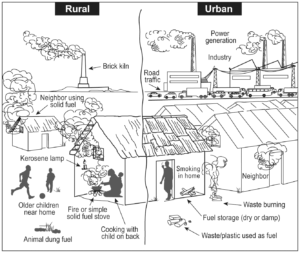
CHALLENGES AND SOLUTIONS
Given the diversity across and within each State, the challenges and solutions are many and the adoption of new technologies and extent of an intervention will require a major shift in culture and behavior. The transition to clean technology and modern fuels remain a challenge despite concerted efforts over the past three decades.
The initial roll-out of the IC stoves failed due to challenges in implementation strategy and the models were not user-friendly, non-durable and lacked repair services. Keeping in mind the traditional factors, better understanding the user’s needs, cooking practices, fuel sources, food and gender dynamics will help to effectively improve future designs with flues, hoods or chimneys.
The primary focus is to provide “stacking” (combined use of stoves and fuels) so households are given a choice to use a variety of methods and fuels based on their cooking needs and energy required, along with provisions for large subsidies.
The rural local bodies to aim at promoting and distributing LPG cylinders to all households in their region by providing subsidies, easy access and ensuring affordable LPG refills.
There is a need for widespread education and awareness campaigns and dissemination of information, targeting the women population by encouraging mothers to keep their young babies away from the fire, briefing on the long-term health damage due to perpetual exposure to smoke and indoor air pollution by traditional stoves. To also consider providing guidance on improved ventilation, demonstration of the new stoves, emphasis on benefits of clean cooking with less-polluting stoves, use of cleaner fuels and introduction to renewable energy.
The key to success will be a coherent strategy keeping in mind the local needs, availability and affordability related to socio-economic, cultural, natural resources, geography and financial factors. It is important for all stakeholders, government authorities, local bodies, public sector, civil society, NGOs and volunteers work together for a smooth transition from traditional practices and encourage adoption of new technologies.
The International Energy Agency (IEA) a Paris-based autonomous intergovernmental organization established in 1974 committed to providing secure and sustainable energy for all, recently released the ‘India Energy Policy Review Report 2020’. The IEA advocates policies, analysis, data and recommendations to all its member countries. The review report highlighted the significant progress by India towards expanding access to electricity and clean cooking and in addition, deploying renewal technologies especially in solar energy. The vision is to bring secure, affordable and sustainable energy to all by strengthening its innovation efforts and build a joint vision and roadmap among all stakeholders.
A continued focus and targeted implementation and monitoring efforts will contribute significantly to achieving clean cooking as a key driver of the Sustainable Development Goals success. However, with India’s rapidly growing economy with an estimated population close to 1.4 billion and over 65% of the population living in rural areas, will India seize the opportunity or miss the target?
